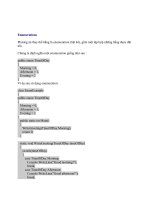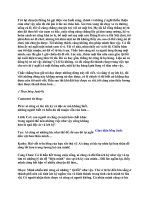Verilog Programming part 10 pdf
Bạn đang xem bản rút gọn của tài liệu. Xem và tải ngay bản đầy đủ của tài liệu tại đây (31 KB, 5 trang )
The truth tables for these gates are very simple. Truth tables for gates with one
input and one output are shown in Table 5-2
.
Table 5-2. Truth Tables for Buf/Not Gates
Bufif/notif
Gates with an additional control signal on buf and not gates are also available.
bufif1 notif1
bufif0 notif0
These gates propagate only if their control signal is asserted. They propagate z if
their control signal is deasserted. Symbols for bufif/notif are shown in Figure 5-3
.
Figure 5-3. Gates Bufif and Notif
The truth tables for these gates are shown in Table 5-3
.
Table 5-3. Truth Tables for Bufif/Notif Gates
These gates are used when a signal is to be driven only when the control signal is
asserted. Such a situation is applicable when multiple drivers drive the signal.
These drivers are designed to drive the signal on mutually exclusive control
signals. Example 5-3
shows examples of instantiation of bufif and notif gates.
Example 5-3 Gate Instantiations of Bufif/Notif Gates
//Instantiation of bufif gates.
bufif1 b1 (out, in, ctrl);
bufif0 b0 (out, in, ctrl);
//Instantiation of notif gates
notif1 n1 (out, in, ctrl);
notif0 n0 (out, in, ctrl);
5.1.3 Array of Instances
There are many situations when repetitive instances are required. These instances
differ from each other only by the index of the vector to which they are connected.
To simplify specification of such instances, Verilog HDL allows an array of
primitive instances to be defined.
[1]
Example 5-4 shows an example of an array of
instances.
[1]
Refer to the IEEE Standard Verilog Hardware Description Language document
for detailed information on the use of an array of instances.
Example 5-4 Simple Array of Primitive Instances
wire [7:0] OUT, IN1, IN2;
// basic gate instantiations.
nand n_gate[7:0](OUT, IN1, IN2);
// This is equivalent to the following 8 instantiations
nand n_gate0(OUT[0], IN1[0], IN2[0]);
nand n_gate1(OUT[1], IN1[1], IN2[1]);
nand n_gate2(OUT[2], IN1[2], IN2[2]);
nand n_gate3(OUT[3], IN1[3], IN2[3]);
nand n_gate4(OUT[4], IN1[4], IN2[4]);
nand n_gate5(OUT[5], IN1[5], IN2[5]);
nand n_gate6(OUT[6], IN1[6], IN2[6]);
nand n_gate7(OUT[7], IN1[7], IN2[7]);
5.1.4 Examples
Having understood the various types of gates available in Verilog, we will discuss
a real example that illustrates design of gate-level digital circuits.
Gate-level multiplexer
We will design a 4-to-1 multiplexer with 2 select signals. Multiplexers serve a
useful purpose in logic design. They can connect two or more sources to a single
destination. They can also be used to implement boolean functions. We will
assume for this example that signals s1 and s0 do not get the value x or z. The I/O
diagram and the truth table for the multiplexer are shown in Figure 5-4
. The I/O
diagram will be useful in setting up the port list for the multiplexer.
Figure 5-4. 4-to-1 Multiplexer
We will implement the logic for the multiplexer using basic logic gates. The logic
diagram for the multiplexer is shown in Figure 5-5
.
Figure 5-5. Logic Diagram for Multiplexer
The logic diagram has a one-to-one correspondence with the Verilog description.
The Verilog description for the multiplexer is shown in Example 5-5
. Two
intermediate nets, s0n and s1n, are created; they are complements of input signals
s1 and s0. Internal nets y0, y1, y2, y3 are also required. Note that instance names
are not specified for primitive gates, not, and, and or. Instance names are optional
for Verilog primitives but are mandatory for instances of user-defined modules.
Example 5-5 Verilog Description of Multiplexer
// Module 4-to-1 multiplexer. Port list is taken exactly from
// the I/O diagram.
module mux4_to_1 (out, i0, i1, i2, i3, s1, s0);
// Port declarations from the I/O diagram
output out;
input i0, i1, i2, i3;
input s1, s0;
// Internal wire declarations
wire s1n, s0n;
wire y0, y1, y2, y3;
// Gate instantiations
// Create s1n and s0n signals.
not (s1n, s1);
not (s0n, s0);
// 3-input and gates instantiated
and (y0, i0, s1n, s0n);
and (y1, i1, s1n, s0);
and (y2, i2, s1, s0n);
and (y3, i3, s1, s0);
// 4-input or gate instantiated
or (out, y0, y1, y2, y3);
endmodule
This multiplexer can be tested with the stimulus shown in Example 5-6
. The
stimulus checks that each combination of select signals connects the appropriate
input to the output. The signal OUTPUT is displayed one time unit after it changes.
System task $monitor could also be used to display the signals when they change
values.
Example 5-6 Stimulus for Multiplexer
// Define the stimulus module (no ports)
module stimulus;
// Declare variables to be connected
// to inputs
reg IN0, IN1, IN2, IN3;
reg S1, S0;
// Declare output wire
wire OUTPUT;
// Instantiate the multiplexer
mux4_to_1 mymux(OUTPUT, IN0, IN1, IN2, IN3, S1, S0);
// Stimulate the inputs
// Define the stimulus module (no ports)
initial
begin
// set input lines
IN0 = 1; IN1 = 0; IN2 = 1; IN3 = 0;
#1 $display("IN0= %b, IN1= %b, IN2= %b, IN3= %b\n",IN0,IN1,IN2,IN3);
// choose IN0
S1 = 0; S0 = 0;
#1 $display("S1 = %b, S0 = %b, OUTPUT = %b \n", S1, S0, OUTPUT);
// choose IN1
S1 = 0; S0 = 1;
#1 $display("S1 = %b, S0 = %b, OUTPUT = %b \n", S1, S0, OUTPUT);
// choose IN2
S1 = 1; S0 = 0;
#1 $display("S1 = %b, S0 = %b, OUTPUT = %b \n", S1, S0, OUTPUT);
// choose IN3
S1 = 1; S0 = 1;
#1 $display("S1 = %b, S0 = %b, OUTPUT = %b \n", S1, S0, OUTPUT);
end
endmodule
The output of the simulation is shown below. Each combination of the select
signals is tested.
IN0= 1, IN1= 0, IN2= 1, IN3= 0
S1 = 0, S0 = 0, OUTPUT = 1
S1 = 0, S0 = 1, OUTPUT = 0
S1 = 1, S0 = 0, OUTPUT = 1
S1 = 1, S0 = 1, OUTPUT = 0
4-bit Ripple Carry Full Adder
In this example, we design a 4-bit full adder whose port list was defined in Section
4.2.1, List of Ports. We use primitive logic gates, and we apply stimulus to the 4-
bit full adder to check functionality . For the sake of simplicity, we will implement
a ripple carry adder. The basic building block is a 1-bit full adder. The
mathematical equations for a 1-bit full adder are shown below.









